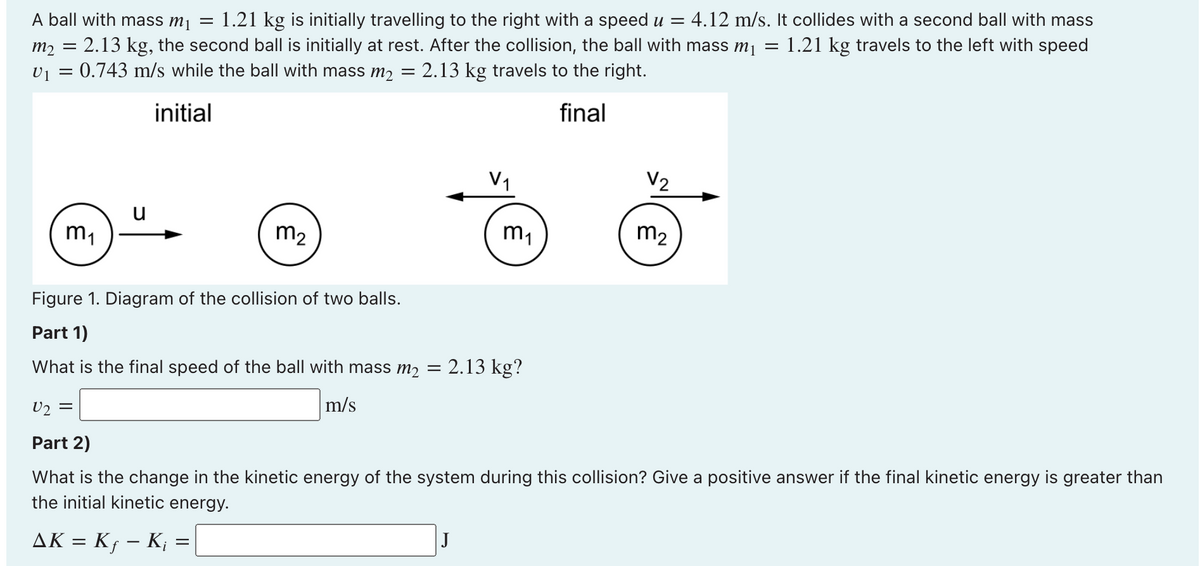A ball with mass mj = 1.21 kg is initially travelling to the right with a speed u = 4.12 m/s. It collides with a second ball with mass m2 = 2.13 kg, the second ball is initially at rest. After the collision, the ball with mass mj = 1.21 kg travels to the left with speed U1 = 0.743 m/s while the ball with mass m2 = 2.13 kg travels to the right. initial final V2 u m1 m2 m1 m2 Figure 1. Diagram of the collision of two balls. Part 1) What is the final speed of the ball with mass m2 = 2.13 kg? U2 = m/s Part 2) What is the change in the kinetic energy of the system during this collision? Give a positive answer if the final kinetic energy is greater than the initial kinetic energy. AK = K¡ – K¡ =
A ball with mass mj = 1.21 kg is initially travelling to the right with a speed u = 4.12 m/s. It collides with a second ball with mass m2 = 2.13 kg, the second ball is initially at rest. After the collision, the ball with mass mj = 1.21 kg travels to the left with speed U1 = 0.743 m/s while the ball with mass m2 = 2.13 kg travels to the right. initial final V2 u m1 m2 m1 m2 Figure 1. Diagram of the collision of two balls. Part 1) What is the final speed of the ball with mass m2 = 2.13 kg? U2 = m/s Part 2) What is the change in the kinetic energy of the system during this collision? Give a positive answer if the final kinetic energy is greater than the initial kinetic energy. AK = K¡ – K¡ =
Physics for Scientists and Engineers, Technology Update (No access codes included)
9th Edition
ISBN:9781305116399
Author:Raymond A. Serway, John W. Jewett
Publisher:Raymond A. Serway, John W. Jewett
Chapter9: Linear Momentum And Collisions
Section: Chapter Questions
Problem 9.44P: The mass of the blue puck in Figure P9.44 is 20.0% greater than the mass of the green puck. Before...
Related questions
Topic Video
Question

Transcribed Image Text:A ball with mass m¡ =
1.21 kg is initially travelling to the right with a speed u = 4.12 m/s. It collides with a second ball with mass
m2 = 2.13 kg, the second ball is initially at rest. After the collision, the ball with mass m1 = 1.21 kg travels to the left with speed
v1 = 0.743 m/s while the ball with mass m2 = 2.13 kg travels to the right.
initial
final
V2
u
m1
m2
m1
m2
Figure 1. Diagram of the collision of two balls.
Part 1)
What is the final speed of the ball with mass m2 =
2.13 kg?
m/s
U2
Part 2)
What is the change in the kinetic energy of the system during this collision? Give a positive answer if the final kinetic energy is greater than
the initial kinetic energy.
AK = K¡ – K¡ =
Expert Solution
This question has been solved!
Explore an expertly crafted, step-by-step solution for a thorough understanding of key concepts.
Step by step
Solved in 3 steps with 3 images

Knowledge Booster
Learn more about
Need a deep-dive on the concept behind this application? Look no further. Learn more about this topic, physics and related others by exploring similar questions and additional content below.Recommended textbooks for you

Physics for Scientists and Engineers, Technology …
Physics
ISBN:
9781305116399
Author:
Raymond A. Serway, John W. Jewett
Publisher:
Cengage Learning

Principles of Physics: A Calculus-Based Text
Physics
ISBN:
9781133104261
Author:
Raymond A. Serway, John W. Jewett
Publisher:
Cengage Learning

Physics for Scientists and Engineers: Foundations…
Physics
ISBN:
9781133939146
Author:
Katz, Debora M.
Publisher:
Cengage Learning

Physics for Scientists and Engineers, Technology …
Physics
ISBN:
9781305116399
Author:
Raymond A. Serway, John W. Jewett
Publisher:
Cengage Learning

Principles of Physics: A Calculus-Based Text
Physics
ISBN:
9781133104261
Author:
Raymond A. Serway, John W. Jewett
Publisher:
Cengage Learning

Physics for Scientists and Engineers: Foundations…
Physics
ISBN:
9781133939146
Author:
Katz, Debora M.
Publisher:
Cengage Learning

Physics for Scientists and Engineers with Modern …
Physics
ISBN:
9781337553292
Author:
Raymond A. Serway, John W. Jewett
Publisher:
Cengage Learning

College Physics
Physics
ISBN:
9781285737027
Author:
Raymond A. Serway, Chris Vuille
Publisher:
Cengage Learning

College Physics
Physics
ISBN:
9781305952300
Author:
Raymond A. Serway, Chris Vuille
Publisher:
Cengage Learning